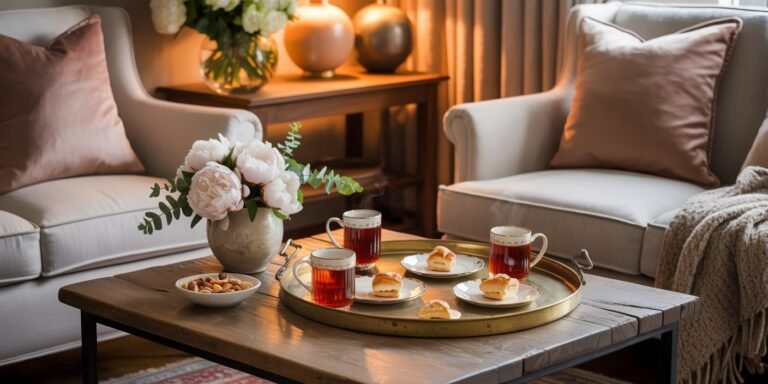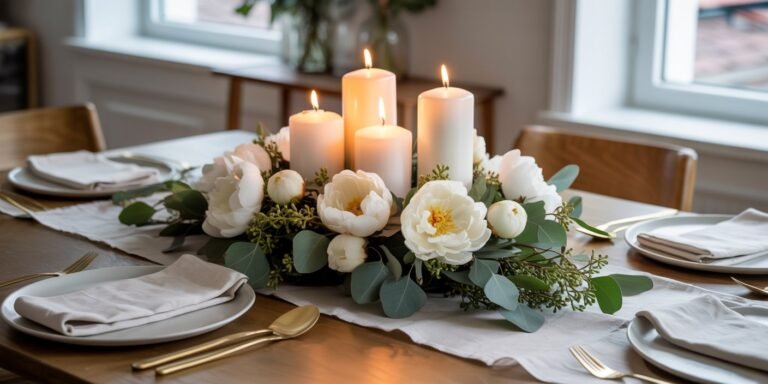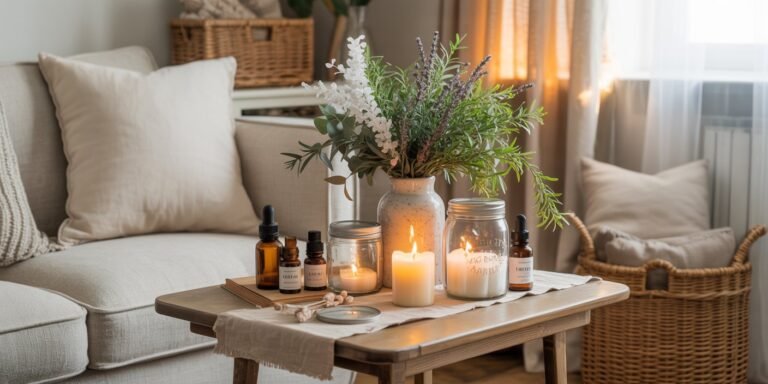In the midst of a busy life, it’s easy to feel like there’s never a moment to yourself. Between work, errands, and daily responsibilities, carving out a personal space can feel impossible.
That’s why I fell in love with the idea of creating a hobby room—a dedicated corner of the house that’s all about me, my passions, and my peace.
When I first started setting up my own hobby room, I wasn’t even sure where to begin.
I had craft supplies, a stack of books, and a few musical instruments, but they were scattered across the house, leaving me feeling more cluttered than inspired.
Over time, I realized that transforming a room into a personal sanctuary wasn’t about filling it with things—it was about curating it with intention, comfort, and creativity.
A hobby room can be anything you want it to be: a space for painting, reading, writing, crafting, or even just sitting quietly with a cup of tea.
It’s a retreat that allows you to recharge, create, and focus on the activities that bring you joy.
With the right setup, thoughtful organization, and a few decorative touches, your hobby room can become the ultimate sanctuary—a place where stress fades, inspiration thrives, and your personal passions take center stage.
Here are my top ideas to turn any hobby room into a sanctuary you’ll love to spend time in, no matter the size or style of your space.
1. Define Your Purpose and Theme
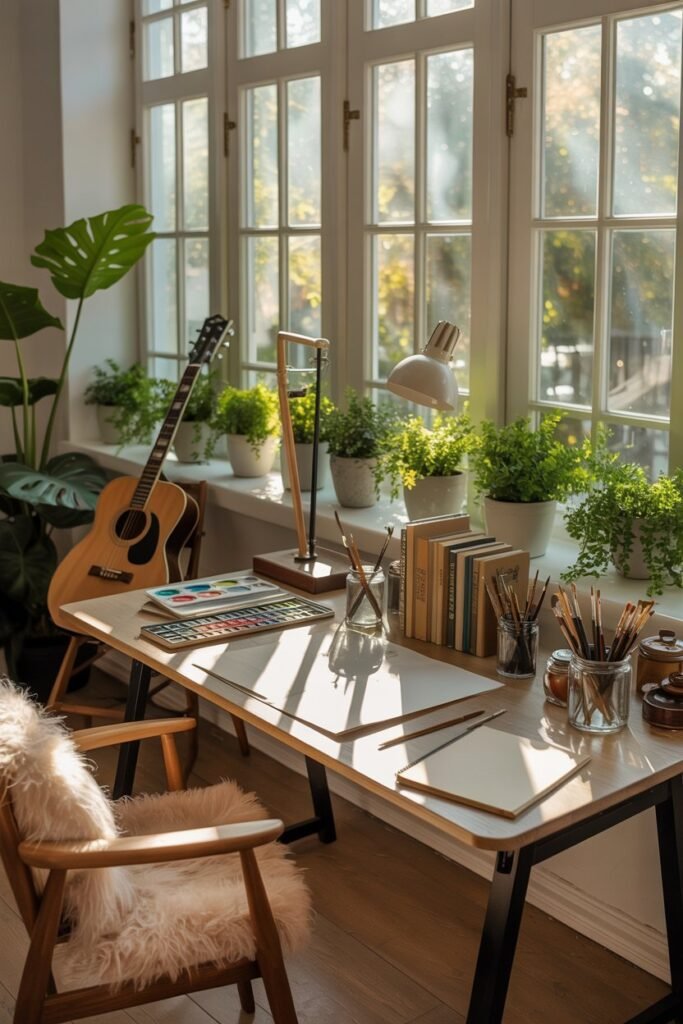
Before adding furniture or decorations, it’s essential to clarify the purpose of your hobby room.
I spent weeks wondering if it should be a craft space, a reading nook, or a music corner—and trying to do everything at once left me feeling overwhelmed.
Once I decided on a primary focus, everything else fell into place naturally.
How to Prepare:
- List the activities you want to do in the room. Is it painting, sewing, writing, or just relaxing?
- Choose a theme or style that inspires you—modern minimalist, cozy rustic, or vibrant eclectic.
- Consider storage needs for your specific hobby items so the space stays functional and clutter-free.
Pro Tip: Pick a color palette that matches the mood you want. Soft neutrals create calm, bright colors energize creativity, and darker shades encourage focus. The theme will guide your furniture, decor, and even lighting choices.
2. Invest in Functional and Comfortable Furniture
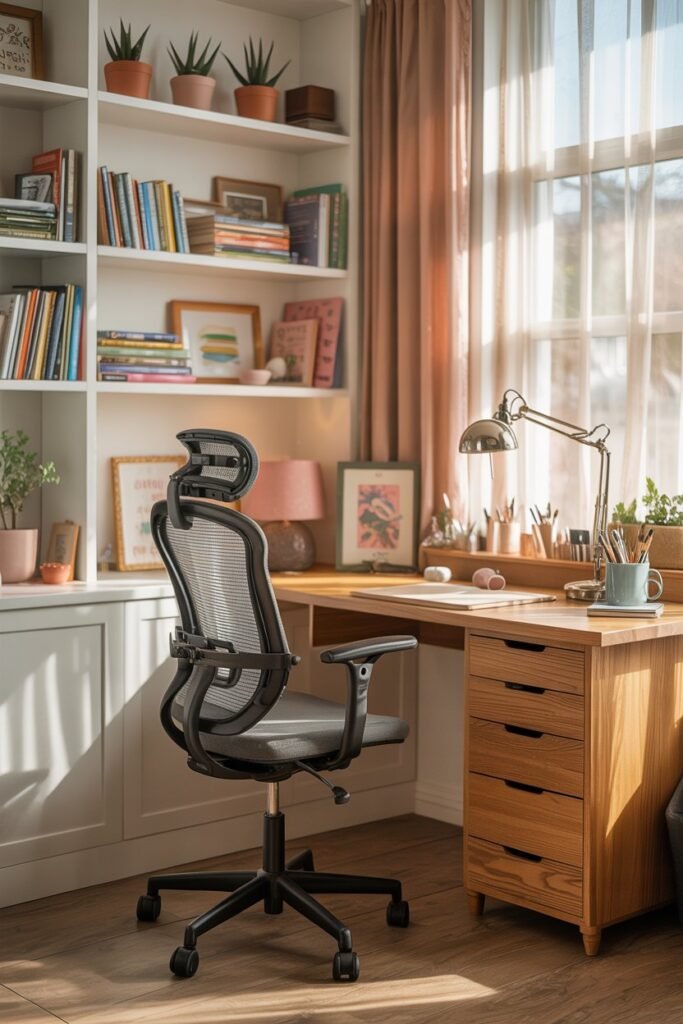
A sanctuary isn’t just about aesthetics—it’s about comfort and usability. I learned this the hard way after spending hours on a small, uncomfortable chair while trying to write.
Now, I prioritize furniture that is both functional and comfortable, ensuring I can spend hours in my hobby room without fatigue.
How to Prepare:
- Choose a chair or seating that supports long periods of use, whether it’s a cushioned reading chair or an ergonomic desk chair.
- Use tables, desks, or work surfaces that fit your activities. A painter will need a sturdy easel or table, while a reader may only need a small side table for books and tea.
- Include storage options like shelves, drawers, or bins to keep tools and materials organized.
Pro Tip: Multi-functional furniture is a lifesaver in smaller rooms. A storage ottoman or wall-mounted shelves can provide space for supplies without taking up floor space. Comfort and function should always come first.
3. Optimize Lighting for Mood and Productivity

Lighting can make or break your hobby room. I used to rely on the ceiling light alone, only to find myself squinting at my sketchbook or straining my eyes while reading.
Natural light is ideal, but when that’s limited, layered lighting can create both a practical and relaxing atmosphere.
How to Prepare:
- Position your desk or workspace near windows for natural daylight whenever possible.
- Add task lighting like desk lamps or adjustable floor lamps for focused activities.
- Use warm, ambient lights or string lights to make the room cozy during evenings or downtime.
Pro Tip: Consider dimmable lighting for flexibility. You can brighten the room when working on a detailed project or soften it for relaxing and reflection.
A mix of natural, task, and ambient light will enhance productivity and comfort.
4. Personalize with Meaningful Decor

A hobby room becomes a sanctuary when it reflects you. I remember the first time I added personal touches to my space—framed artwork I loved, a few travel souvenirs, and a small plant.
Suddenly, the room felt alive, welcoming, and uniquely mine.
How to Prepare:
- Incorporate items that inspire you or bring back happy memories—photos, artwork, or collectibles.
- Choose decorative pieces that match your hobby and theme. For example, vintage jars for craft supplies or a sleek magazine holder for a reading nook.
- Don’t overcrowd the space; select a few meaningful items to maintain calm and order.
Pro Tip: Rotate décor seasonally or based on your mood. Even small changes like fresh flowers, a new throw, or a decorative bowl can refresh the space and make it feel new again.
5. Add Plants and Natural Elements

Plants bring life, color, and tranquility to any room. I started with a small potted plant on my desk, and over time, I added a few more around the room.
Not only did the space look more vibrant, but the greenery helped me feel calmer and more focused while working on projects.
How to Prepare:
- Select plants that are easy to care for, such as succulents, snake plants, or pothos.
- Place them near natural light sources if possible, but choose varieties that tolerate low light for darker corners.
- Incorporate natural elements like wooden trays, stone coasters, or a woven basket to complement the plants and create texture.
Pro Tip: Rotate plants occasionally to keep them healthy and visually appealing. Even a single plant on a shelf or windowsill can enhance the room’s ambiance and help you feel more connected to nature.
6. Organize Supplies for Efficiency and Calm

A cluttered hobby room quickly becomes stressful instead of relaxing. I learned that proper storage isn’t just practical—it’s essential for creating a peaceful sanctuary.
Every time I organized my supplies by category and gave everything a home, I noticed I could focus on my hobbies without distraction.
How to Prepare:
- Group similar items together (paints, yarn, books, tools) and store them in labeled bins, shelves, or drawers.
- Use vertical space with wall-mounted shelves or pegboards to free up floor space.
- Keep frequently used items easily accessible, while storing seasonal or less-used supplies out of sight.
Pro Tip: Maintain a regular tidying routine. Spending 5–10 minutes at the end of each session to put things away keeps the space welcoming and prevents clutter from building up. Organization enhances both creativity and relaxation.
7. Create a Cozy Nook for Reflection and Relaxation

A true sanctuary includes a spot to simply sit, breathe, and enjoy the room without actively working on a hobby.
I set up a small corner with a comfy chair, soft throw, and a side table for tea or a journal. It quickly became my favorite spot for thinking, reading, or just letting my mind wander.
How to Prepare:
- Choose a chair or bench with cushions and a soft throw for ultimate comfort.
- Include a small side table for drinks, books, or notebooks.
- Position the nook near natural light or with soft ambient lighting to make it inviting at any time of day.
Pro Tip: Add personal touches like a favorite candle, a small plant, or a stack of inspiring books.
Even a simple cozy corner can transform the room into a space where creativity flows naturally and stress melts away.
8. Incorporate Music or Sound
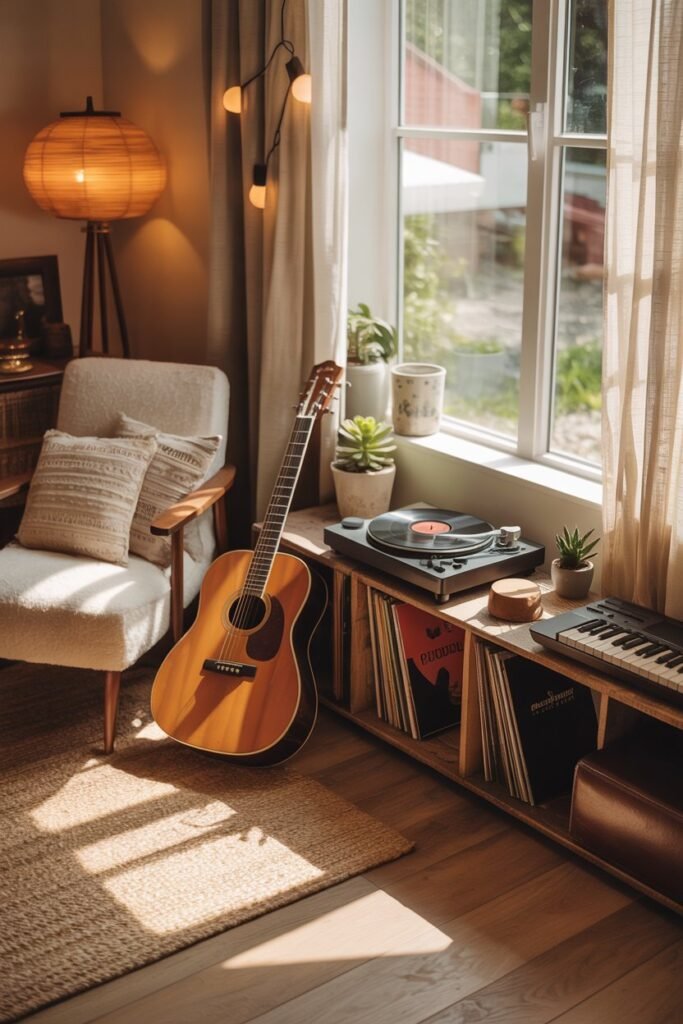
Sound has an incredible effect on mood and focus. When I added a small Bluetooth speaker to my hobby room, it completely transformed the space.
Background music, nature sounds, or even white noise can help you relax, stay inspired, or concentrate on projects.
How to Prepare:
- Choose a sound system that fits your space—a small Bluetooth speaker or smart speaker works well.
- Curate playlists tailored to your hobby: calming music for reading or crafting, upbeat tracks for exercise or dancing.
- Consider noise-canceling options if your hobby room is near busy areas of the home.
Pro Tip: Keep volume at a comfortable level that enhances focus without being distracting. Even a subtle background track can make the room feel more inviting and personal.
9. Ensure Comfort and Ergonomics
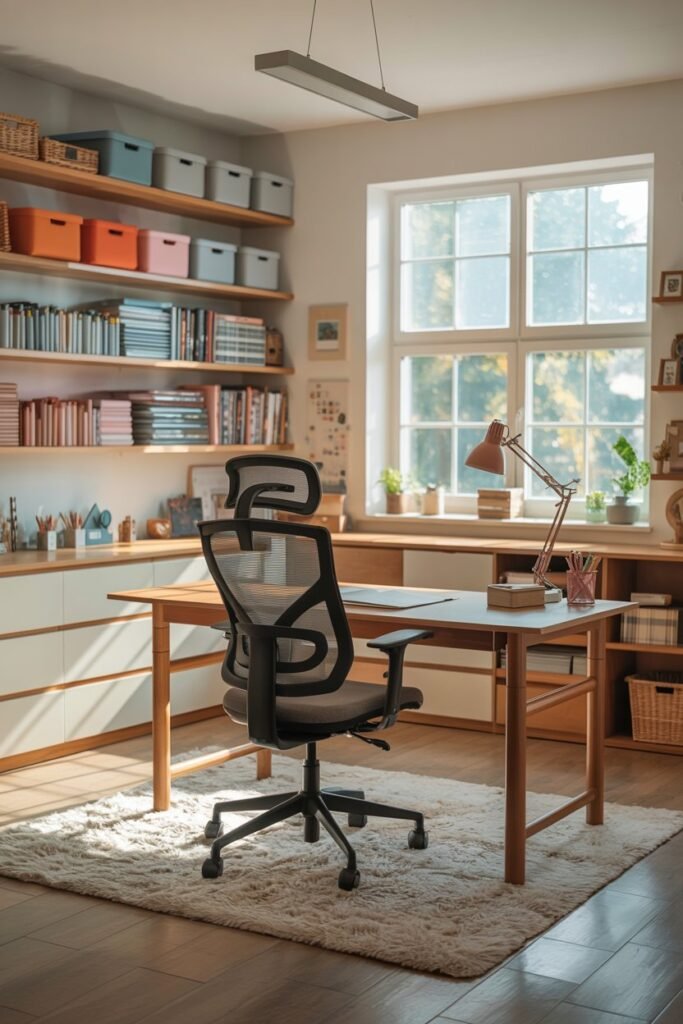
A hobby room should be comfortable for long sessions. I realized I was getting neck strain from poor seating and wrist pain from my desk setup, so I upgraded my chair, desk, and lighting to support proper posture.
Comfort is essential for making the room feel like a true sanctuary.
How to Prepare:
- Invest in ergonomic seating and work surfaces suitable for your hobbies.
- Ensure lighting is adequate for detailed work without straining your eyes.
- Use cushions, footrests, or adjustable chairs to maintain good posture.
Pro Tip: Test your setup periodically. Small adjustments can prevent discomfort and make your hobby room a place you genuinely look forward to spending time in.
10. Keep It Flexible and Adaptable
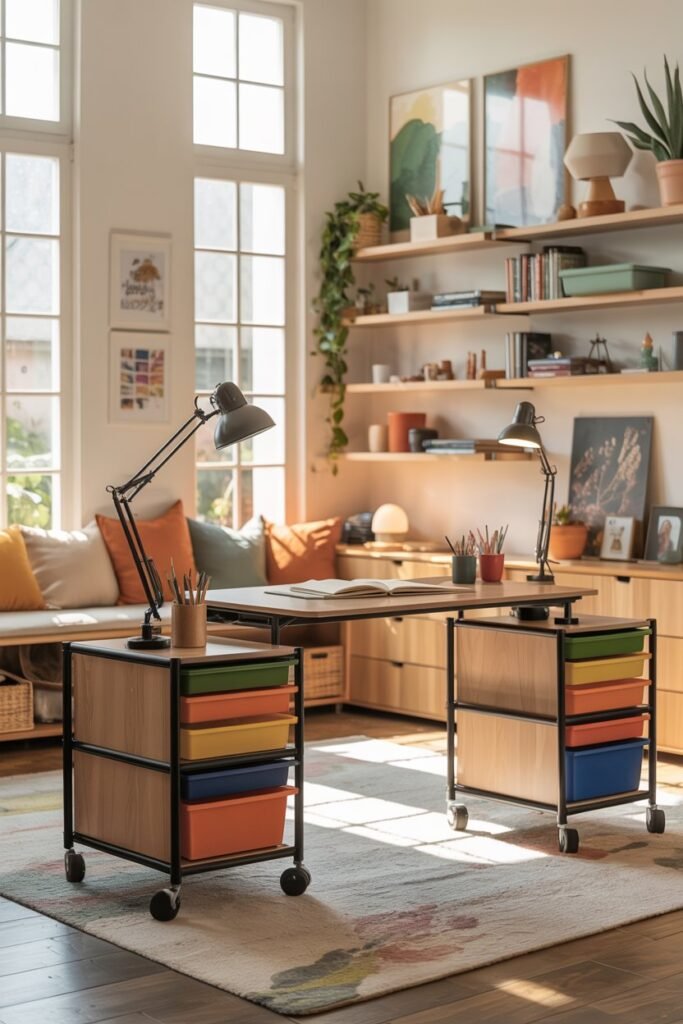
Your hobby room should evolve with your interests. I started with a craft-focused room, but over time added a reading nook, writing corner, and small music area.
Flexibility ensures the room continues to meet your needs and inspires creativity.
How to Prepare:
- Use modular furniture and movable storage so the layout can change easily.
- Keep some open space for future projects or hobbies.
- Regularly assess how you use the room and adjust decor or organization as needed.
Pro Tip: Don’t be afraid to experiment. Sometimes adding a small piece of furniture, a new light, or rearranging storage can breathe new life into your sanctuary.
Final Thoughts
Creating a hobby room is about more than having a designated space—it’s about crafting a personal sanctuary that reflects your personality, supports your passions, and nurtures your well-being.
From defining the purpose of the room to organizing supplies, incorporating natural elements, and creating cozy corners, each detail contributes to a calm, inspiring environment.
The best hobby rooms balance functionality and comfort. They are a place to explore creativity, unwind after a long day, and immerse yourself fully in activities you love.
With thoughtful planning and personal touches, your hobby room can become the ultimate retreat—a space where stress fades, ideas flourish, and every visit feels restorative.
Short FAQ
1. How big does a hobby room need to be?
Size isn’t critical. Even a small corner can serve as a sanctuary if organized efficiently and designed with intention.
2. What types of hobbies work best in a dedicated room?
Any hobby can benefit from a dedicated space: crafting, painting, reading, writing, music, meditation, or DIY projects.
3. How do I make a small hobby room feel spacious?
Use vertical storage, multi-functional furniture, and light colors. Keeping the room organized and clutter-free also creates a sense of openness.
4. Do I need to spend a lot of money to create a sanctuary?
No. Thoughtful organization, personal touches, lighting, and comfort matter more than expensive furniture or decor.
5. How can I keep the room inspiring over time?
Rotate decorations, update lighting, refresh plants, and reorganize supplies periodically. Allow flexibility for new hobbies or projects to keep the room dynamic.


